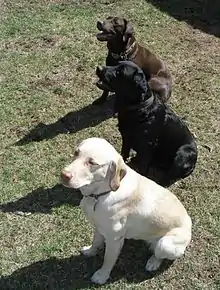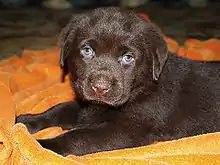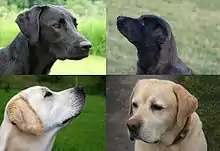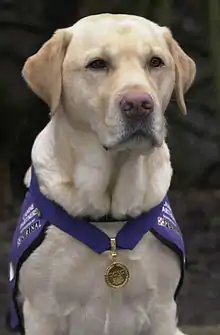Labrador Retriever
The Labrador Retriever or simply Labrador is a British breed of retriever gun dog. It was developed in the United Kingdom from fishing dogs imported from the colony of Newfoundland (now a province of Canada), and was named after the Labrador region of that colony. It is among the most commonly kept dogs in several countries, particularly in the Western world.
| Labrador retriever | |||||||||||||||||||||||||||||
|---|---|---|---|---|---|---|---|---|---|---|---|---|---|---|---|---|---|---|---|---|---|---|---|---|---|---|---|---|---|
.jpg.webp) | |||||||||||||||||||||||||||||
| Other names | Labrador | ||||||||||||||||||||||||||||
| Common nicknames | Lab | ||||||||||||||||||||||||||||
| Origin | United Kingdom | ||||||||||||||||||||||||||||
| Foundation stock | St. John's water dog | ||||||||||||||||||||||||||||
| |||||||||||||||||||||||||||||
| |||||||||||||||||||||||||||||
| Dog (domestic dog) | |||||||||||||||||||||||||||||
The Labrador is friendly, energetic, and playful.[2] It was bred as a sporting and hunting dog but is widely kept as a companion dog. It may also be trained as a guide or assistance dog, or for rescue or therapy work.[3]
In the 1830s, the 10th Earl of Home and his nephews the 5th Duke of Buccleuch and Lord John Scott,[4] imported progenitors of the breed from Newfoundland to Europe for use as gun dogs. Another early advocate of these Newfoundland fishing dogs was the 2nd Earl of Malmesbury, who bred them for their expertise in waterfowling.[4]
During the 1880s, the 3rd Earl of Malmesbury, the 6th Duke of Buccleuch, and the 12th Earl of Home collaborated to develop and establish the Labrador Retriever breed. The dogs Buccleuch Avon and Buccleuch Ned, given by Malmesbury to Buccleuch, were mated with bitches carrying blood from those originally imported by the 5th Duke and the 10th Earl of Home. The offspring are the ancestors of all modern Labradors.
History
.png.webp)
The Labrador breed dates back to at least the 1830s, when St. John's water dogs bred by European settlers in Newfoundland, were first introduced to Britain from ships trading between Canada and Poole in Dorsetshire. These were then bred with British hunting dogs to create what became known as the Labrador Retriever. Its early patrons included the Earl of Malmesbury, the Duke of Buccleuch, the Earl of Home, and Sir John Scott. Early writers have confused the Labrador with the much larger Newfoundland and the Lesser Newfoundland, with Charles St. John even referring to the Lesser Newfoundland as the Newfoundland. Colonel Peter Hawker describes the first Labrador as being not larger than an English Pointer, more often black than other colours, long in its head and nose with a deep chest, fine legs, and short and smooth coat, and did not carry its tail as highly as the Newfoundland.[5] Hawker distinguishes the Newfoundland from both the "proper Labrador" and St. John's breed of these dogs[5][6] in the fifth edition of his book Introductions to Young Sportsman, published in 1846.[6]
The first photograph of the breed was taken in 1857 (the Earl of Home's dog "Nell", described both as a Labrador and a St. John's water dog). By 1870, the name Labrador Retriever became common in England.[7] The first yellow Labrador on record was born in 1899 (Ben of Hyde, kennels of Major C.J. Radclyffe), and the breed was recognised by the Kennel Club in 1903.[8] The first American Kennel Club (AKC) registration was in 1917. The Liver (now typically called Chocolate) Labrador emerged in the late 1800s, with liver-coloured pups documented at the Buccleuch kennels in 1892.
Characteristics


.jpg.webp)
There is a great deal of variety among Labradors. The following characteristics are typical of the conformation show bred (bench-bred) lines of this breed in the United States and are based on the American Kennel Club standard.[2] Significant differences between UK and U.S. standards are noted.
- Size: Labradors are a medium-large breed. They should be as long from the withers to the base of the tail as they are from the floor to the withers. The AKC standard includes an ideal weight for dogs of 25–36 kg (55–80 lb) and for bitches as 25–32 kg (55–70 lb).[2] The guidelines for height vary between the AKC, which gives 55 to 62 centimetres (21.5 to 24.5 in) for dogs and 55 to 60 centimetres (21.5 to 23.5 in) for bitches,[2] The Kennel Club which advises that dogs should be 56 to 57 centimetres (22 to 22.5 in) with bitches between 55 to 56 centimetres (21.5 to 22 in),[9] and the FCI which quotes a range of 56 to 57 centimetres (22 to 22.5 in) for dogs with bitches ideal at 54 to 56 centimetres (21.5 to 22 in).[10]
- Coat: The Labrador Retriever's coat should be short and dense, but not wiry. The coat is water-resistant, so the dog does not get cold when taking to the water in the winter. That means that the dog naturally has a slightly dry, oily coat. Acceptable colours are black, yellow, and chocolate.[11]
- Head: The head should be broad with slightly pronounced eyebrows. The eyes should be kind and expressive. Appropriate eye colours are brown and hazel. The lining around the eyes should be black. The ears should hang close to the head and be set slightly above the eyes.
- Jaws: The jaws should be strong and powerful. The muzzle should be of medium length and should not be too tapered. The jaws should hang slightly and curve gracefully back.
- Body: The body should have a powerful and muscular build.
The tail and coat are designated "distinctive [or distinguishing] features" of the Labrador by both the Kennel Club and AKC.[2][9] The AKC adds that the "true Labrador Retriever temperament is as much a hallmark of the breed as the 'otter' tail."[2]
Colour

Labradors are registered in three colours: solid black, yellow (considered from creamy white to fox-red) and chocolate (medium to dark brown and originally called "liver"). [12]
Puppies of all colours can occur in the same litter. Coat colour is determined primarily by three genes. The first gene (the B locus) determines the density of the coat's eumelanin pigment granules, if that pigment is allowed: dense granules result in a black coat, and sparse ones give a chocolate coat. The second (E) locus determines whether the eumelanin is produced at all. A dog with the recessive e allele will produce only phaeomelanin pigment and will be yellow regardless of its genotype at the B locus. The genes known previously have had their number increased by the introduction of the K locus, where the dominant "black" allele KB is now known to reside.[13]
According to a 2011 study, 13 out of 245 Labradors studied were heterozygous for the M264V mutation responsible for the melanistic mask, and one was homozygous. Within the breed, this trait is not visible.[14]

Show and field lines

As a result of specialised breeding, there are significant differences between field and trial-bred and show-bred lines of Labradors. In the United States, the former are sometimes mistakenly referred to as "American" and the latter as "English", in fact, both field and show types are bred in both countries and all Labrador Retrievers are descended from British lines.[15]
Use

Labrador Retrievers have proven to have a high success rate at becoming guide dogs. A study was recently done on how well four different breeds (Labrador Retriever, Golden Retriever, Labrador Retriever/Golden Retriever Mix, and German Shepherds) trained to become guide dogs. In this experiment, German Shepherds had the highest chance of not completing it. Labrador Retrievers and Labrador Retriever/Golden Retriever Mix had the highest success rate. However, German Shepherds and Golden Retrievers had a higher success rate after going through longer training than the training required for Labrador Retrievers.[16][17]
Labradors are powerful and indefatigable swimmers noted for their ability to tolerate the coldest of water for extended periods of time. Their ability to work quietly alongside hunters while watching for birds to fall from the sky, marking where they land and then using their outstanding nose to find and retrieve dead or wounded birds has made them the king of waterfowl retrievers.[18]
They can also be used for pointing and flushing, and make excellent upland game hunting partners.[19]
The high intelligence, initiative and self-direction of Labradors in working roles is exemplified by dogs such as Endal, who was trained to, if need be, put his human who uses a wheelchair in the recovery position, cover him with a blanket, and activate an emergency phone.[20] A number of Labradors have also been taught to assist their owner in removing money and credit cards from ATMs with prior training.[21]
The breed is used in water rescue/lifesaving. It continues in that role today, along with the Leonberger, Newfoundland and Golden Retriever dogs; they are used at the Italian School of Canine Lifeguard.[22]
In war
Labradors have been used as war dogs. During the Vietnam War they were used as scout dogs to track down dead or wounded soldiers or enemy positions.[23]: 278
Health
A Labrador may be expected to live for 10 to 12 years.[1]: 256
It is a healthy breed with relatively few major problems. Notable issues related to health and well-being include inherited disorders and obesity (most are missing all or parts of the appetite-regulating POMC gene).
A Royal Veterinary College study, and one conducted by The University of Sydney, have concluded that chocolate-coloured Labradors have a shorter average life expectancy than other colours of Labrador (by about 10%) and are more likely to suffer some health problems.[24]
Labradors are somewhat prone to hip and elbow dysplasia,[25] especially in larger dogs.[26] Eye diseases may include progressive retinal atrophy, cataracts, corneal dystrophy[25] and retinal dysplasia.[27] They can suffer from exercise induced collapse, which causes hyperthermia, weakness, collapse, and disorientation after short bouts of exercise,[28] or from obesity, which in some cases may be partly due to the absence of part or all of the proopiomelanocortin gene.[29][30]
Demography
The Labrador is an exceptionally popular dog. For example, as of 2006:
- Widely considered the most popular breed in the world.[31]
- Most popular dog by ownership in Australia,[32] Canada, Israel,[33] New Zealand, United Kingdom,[34] and United States (since 1991),[35]
- In both the United Kingdom and the United States, there are well over twice as many Labradors registered as the next most popular breed.[34][35] If the comparison is limited to dog breeds of a similar size, then there are around 3–5 times as many Labradors registered in both countries as the next most popular breeds, the German Shepherd Dog and Golden Retriever.[34][35]
- Most popular breed of assistance dog in the United States, Australia and many other countries,[36] as well as being widely used by police and other official bodies for their detection and working abilities. Approximately 60–70% of all guide dogs in the United States are Labradors (see below).
- Seven out of 13 of the Australian National Kennel Council "Outstanding Gundogs" Hall of Fame appointees are Labradors (list covers 2000–2005).[37]
There is no global stud-book for Labradors, nor is there detailed information on the numbers of Labradors living in each country. In 2005 the five countries with the largest numbers of Labrador registrations are the United Kingdom, France, the United States, Sweden and Finland.[38][39]
OFA statistics suggest that yellow and black Labradors are registered in very similar numbers (yellow slightly more than black); chocolate in lesser numbers.[38][39]
Famous Labradors

Notable labradors within various categories include:
Assistance dogs
- Endal, a service dog[40] in Britain. Among other distinctions, "the most decorated dog in the world" (including "Dog of the Millennium" and the PDSA's Gold Medal for Animal Gallantry and Devotion to Duty), the first dog to ride on the London Eye and the first dog known to work a 'chip and pin' ATM card. By Endal's death in March 2009, he and his owner/handler Allen Parton had been filmed almost 350 times by crews from several countries, and a film of a year in Endal's life was in production.
- Sully, served with former US President George H. W. Bush during the last six months of his life; noted for his role during the president's funeral. A form of Parkinson's disease confined the former president to a wheelchair or motorised scooter in the final years of his life. Among the services that Sully was able to perform for Bush were retrieving dropped items, opening and closing doors, pushing an emergency button and supporting him when standing.[41]
Police, military, rescue and detection dogs
- Zanjeer ("Chain", or "Shackles"), a detection dog who detected arms and ammunition used in the 1993 Mumbai (Bombay) serial explosions. During his service, he helped recover 57 country-made bombs, 175 petrol bombs, 11 military-grade armaments, 242 grenades and 600 detonators. His biggest contribution to the police force and the city was the detection of 3,329 kg of RDX. He also helped detect 18 Type 56 rifles and five 9mm pistols.
- Lucky and Flo, twin Black Labrador counterfeit-detection dogs who became famous in 2007 for "sniffing out nearly 2 million counterfeit DVDs" on a six-month secondment to Malaysia in 2007.[42] Following the multimillion-dollar, 6-arrest Malaysian detection, they became the first dogs to be awarded Malaysia's "outstanding service award"[43] and software pirates were stated to have put a £30,000 contract out for their lives.[44][45]
- Sarbi, an Australian special forces explosives detection dog that spent almost 14 months missing in action (MIA) in Afghanistan before being recovered safe and well in 2009.[46][47]
- Jake, a well-known American black Labrador who served as a search and rescue dog following the September 11 attacks and Hurricane Katrina.[48]
- Salty and Roselle, awarded the Dickin Medal for conspicuous gallantry or devotion to duty while serving in military conflict. Guide dogs, led their blind owners down more than 70 flights of stairs to escape from the damaged World Trade Center in September 2001[49]
- Sadie, awarded the Dickin Medal for conspicuous gallantry or devotion to duty while serving in military conflict. Detected explosive devices, which were subsequently disarmed, while serving in Kabul, Afghanistan, in November 2005; served with the Royal Gloucestershire, Berkshire and Wiltshire Regiment[50]
- Sasha, awarded the Dickin Medal for conspicuous gallantry or devotion to duty while serving in military conflict. Located 15 improvised explosive devices, mortars, mines, and weapons while serving in Afghanistan, with the Royal Army Veterinary Corps. In July 2008 Sasha and her handler were killed in a Taliban ambush by a rocket-propelled grenade.[51][52]
Pets
- Former President of the United States Bill Clinton's Labradors Buddy and Seamus.[53]
- Russian President Vladimir Putin's Labrador 'Konni'.[54]
- Marley, "The World's Worst Dog", featured in journalist John Grogan's autobiographical book Marley & Me, adapted into a 2008 comedy drama film of the same name
References
- Kim Dennis-Bryan (2020 [2012])). The Complete Dog Breed Book, second edition. London: Dorling Kindersley. ISBN 9780241412732.
- "Labrador Retriever Breed Standard". American Kennel Club. 31 March 1994. Retrieved 13 September 2007.
- "AKC Dog Registration Statistics". Akc.org. 4 April 2012. Archived from the original on 11 May 2012. Retrieved 9 April 2012.
- Article written for The Field, 30 May 1896, 'Labrador Dogs', by John S Kerss
- Holland-Hibert, A. (1903). "Ch.XXX - The Labrador". In Drury, William D. (ed.). British dogs, their points, selection, and show preparation (3 ed.). Upcot Gill. pp. 356–358.
- Hawker, Peter (1846). "Dogs". Introductions to Young Sportsman in all that relates to Guns and Shooting (5 ed.). Longman, Hurst, Rees, Orme, Brown, and Green. p. 245.
- "Labrador Retriever". vcahospitals.com. Mars Inc. Retrieved 1 October 2022.
- Ziessow, Bernard. "The Labrador Retriever: Origin and Purpose of the Breed" (PDF). pslra.org. Retrieved 1 October 2022.
- Retriever (Labrador) Breed Standard Archived 31 October 2011 at the Wayback Machine. The Kennel Club.
- Labrador Retriever. Fédération Cynologique Internationale. Accessed May 2020.
- "Get to Know the Labrador Retriever", 'The American Kennel Club', Retrieved 29 May 2014
- "The Kennel Club". The Kennel Club. Archived from the original on 10 January 2015. Retrieved 10 January 2015.
- Candille, Sophie I.; Kaelin, Christopher B.; Cattanach, Bruce M.; Yu, Bin; Thompson, Darren A.; Nix, Matthew A.; Kerns, Julie A.; Schmutz, Sheila M.; Millhauser, Glenn L.; Barsh, Gregory S. (2007). "A β-Defensin Mutation Causes Black Coat Colour in Domestic Dogs". Science. 318 (5855): 1418–23. Bibcode:2007Sci...318.1418C. doi:10.1126/science.1147880. PMC 2906624. PMID 17947548.
- Conant, E.K.; Juras, R.; Cothran, E.G. (2011). "Incidence of the mask phenotype M264V mutation in Labrador Retrievers". Research in Veterinary Science. 91 (3): e98–9. doi:10.1016/j.rvsc.2011.02.002. PMID 21353269.
- American Kennel Club, The Labrador Retriever Club, Inc. "American vs. English". Archived from the original on 5 July 2017. Retrieved 2 September 2012.
- Serpell, James (1995). The Domestic Dog: its Evolution, Behavior and Interactions With People. Cambridge University Press. ISBN 0-521-41529-2.
- Ennik, Irma; Liinamo, Anna-Elisa; Leighton, Eldin; Van Arendonk, Johan (2006). "Suitability for field service in 4 breeds of guide dogs". Journal of Veterinary Behavior: Clinical Applications and Research. 1 (2): 67–74. doi:10.1016/j.jveb.2006.06.004.
- "Labrador Retrievers". deltawaterfowl.org. Delta Waterfowl. 17 June 2021. Retrieved 2 October 2022.
- "Pointing Labs". northernplainsretrievers.com. NORTHERN PLAINS RETRIEVERS. Retrieved 2 October 2022.
- Blystone, Richard; Mallary Gelb (10 August 2000). "Assistance dogs are trained as partners for the disabled". CNN.com. Archived from the original on 17 May 2013.
- "thought this was Bark-lays bank". Metro. 28 February 2007. Retrieved 28 February 2007.
- Manetti, Francesco (23 August 2010). "Italian school teaches dogs to become lifeguards". Los Angeles Times. Associated Press. Retrieved 14 February 2017.
- John C. Burnam (2008). A Soldier's Best Friend; Scout Dogs and their Handlers in the Vietnam War. New York: Sterling Publishing. ISBN 9781402754470.
- "Chocolate Labradors have a shorter lifespan than rest of the breed". VetCompassTM and the University of Sydney Study. Royal Veterinary College. 22 October 2018.
- "Labrador Retriever". Canine Inherited Disorders Database. Archived from the original on 27 September 2007. Retrieved 14 September 2007.
- Newton, C. D.; Nunamaker, D. M. (Eds.) "Textbook of Small Animal Orthopaedics Archived 2007-09-27 at the Wayback Machine." Published by the International Veterinary Information Service (Riser, Rhodes and Newton). p. 2.
- "Retinal Dysplasia/Oculoskeletal Dysplasia 1". pawprintgenetics.com. Retrieved 2 October 2022.
- Taylor, SM; Shmon, CL; Shelton, GD; Patterson, EE; Minor, K; Mickelson, JR (2008). "Exercise Induced Collapse of Labrador Retrievers: Survey results and preliminary investigation of heritability". J Am Anim Hosp Assoc. 44 (6): 295–301. doi:10.5326/0440295. PMID 18981194.
- Raffan, Eleanor (10 May 2016). "A Deletion in the Canine POMC Gene Is Associated with Weight and Appetite in Obesity-Prone Labrador Retriever Dogs". Cell Metabolism. 23 (5): 893–900. doi:10.1016/j.cmet.2016.04.012. PMC 4873617. PMID 27157046.
- Freytas-tamura, Kimiko De (5 July 2016). "The Lab Results Are In: Genes Might Be to Blame for Retrievers' Obesity". The New York Times. ISSN 0362-4331. Retrieved 6 July 2016.
- The Ultimate Labrador Retriever. Howell Book House. 18 April 2003. ASIN 0764526391.
- "National Registration Statistics". Australian National Kennel Council. 2006. Archived from the original on 14 September 2007. Retrieved 13 September 2007.
- "Labrador most popular dog in Israel". Ynetnews. 30 April 2009. Retrieved 12 May 2009.
- "Registration statistics for all recognised dog breeds, 2005 and 2006". UK Kennel Club. 2006. Archived from the original on 4 September 2009. Retrieved 13 September 2007.
- "AKC Dog Registration Statistics". American Kennel Club. 2006. Archived from the original on September 9, 2007. Retrieved September 13, 2007.
- Devantier, Alecia T; Turkington, Carol (2007). Extraordinary Jobs with Animals. Ferguson. p. 20. ISBN 978-1-4381-1170-4.
Labrador Retriever Most popular breed of assistance dog.
- "ANKC Hall of Fame". Australian National Kennel Council. Archived from the original on 19 September 2007. Retrieved 13 September 2007.
- Lanternier, Thomas; Philippe Canal (2004–2005). "Database Statistics". Archived from the original on 29 July 2007. Retrieved 13 September 2007.
{{cite web}}: CS1 maint: bot: original URL status unknown (link) (A historic mirror of this page is available at ) - Vanderwyk, Jack (2004–2005). "Labrador Statistics". Retrieved 13 September 2007.
- "Endal the super dog". Edition.cnn.com. 10 August 2000. Retrieved 6 August 2014.
- ‘Mission complete’: Sully, Bush’s service dog, stays at the former president’s side for one last journey. (3 December 2018). The Seattle Times. https://www.seattletimes.com/nation-world/mission-complete-sully-bushs-service-dog-stays-at-former-presidents-side-for-one-last-journey/
- "Police Dogs Sniff for Pirated DVDs." ABC News. 10 May 2006. Retrieved on 17 September 2007.
- Blass, Evan. "DVD-sniffing dogs awarded medals, returning to NYC." Engadget. 20 August 2007. Retrieved on 17 September 2007.
- Chan, Sewell. "Fresh Off Malaysian Triumph, DVD-Sniffing Dogs Tackle New York." New York Times. 28 August 2007. Retrieved on 17 September 2007.
- Blass, Evan. "DVD pirates put out hits on Lucky and Flo the crime dogs." Engadget. 22 March 2007. Retrieved on 17 September 2007.
- "Australian Dog Returns Home After A Year in the Wilderness". www.defence.gov.au, Defence Media Release. Australian Department of Defence. 12 November 2009. Archived from the original on 27 November 2012. Retrieved 14 November 2009.
- "Handler never gave up on lost army dog". ABC News. 12 November 2009. Archived from the original on 15 November 2009. Retrieved 14 November 2009.
- Glagola, Nick (27 July 2007). "Jake, the Rescue Dog: An Impressive Life". NPR. NPR. Retrieved 18 November 2013.
- "Life Saving" (PDF). Imperial War Museum London. Archived from the original (PDF) on 8 January 2009. Retrieved 17 January 2009.
- "In pictures: Sadie the hero dog gets a medal". BBC. 6 February 2007. Retrieved 27 February 2010.
- "Army dog killed in Afghanistan given posthumous medal". BBC News. 29 April 2014. Retrieved 29 April 2014.
- "British army dog awarded bravery medal for work in Afghanistan". The Guardian. London. 29 April 2014. Retrieved 29 April 2014.
- "Friend of Bill". People. 57 (2). 2002.
- "Putin's Pooches". russianlife.org. Retrieved 2 October 2022.